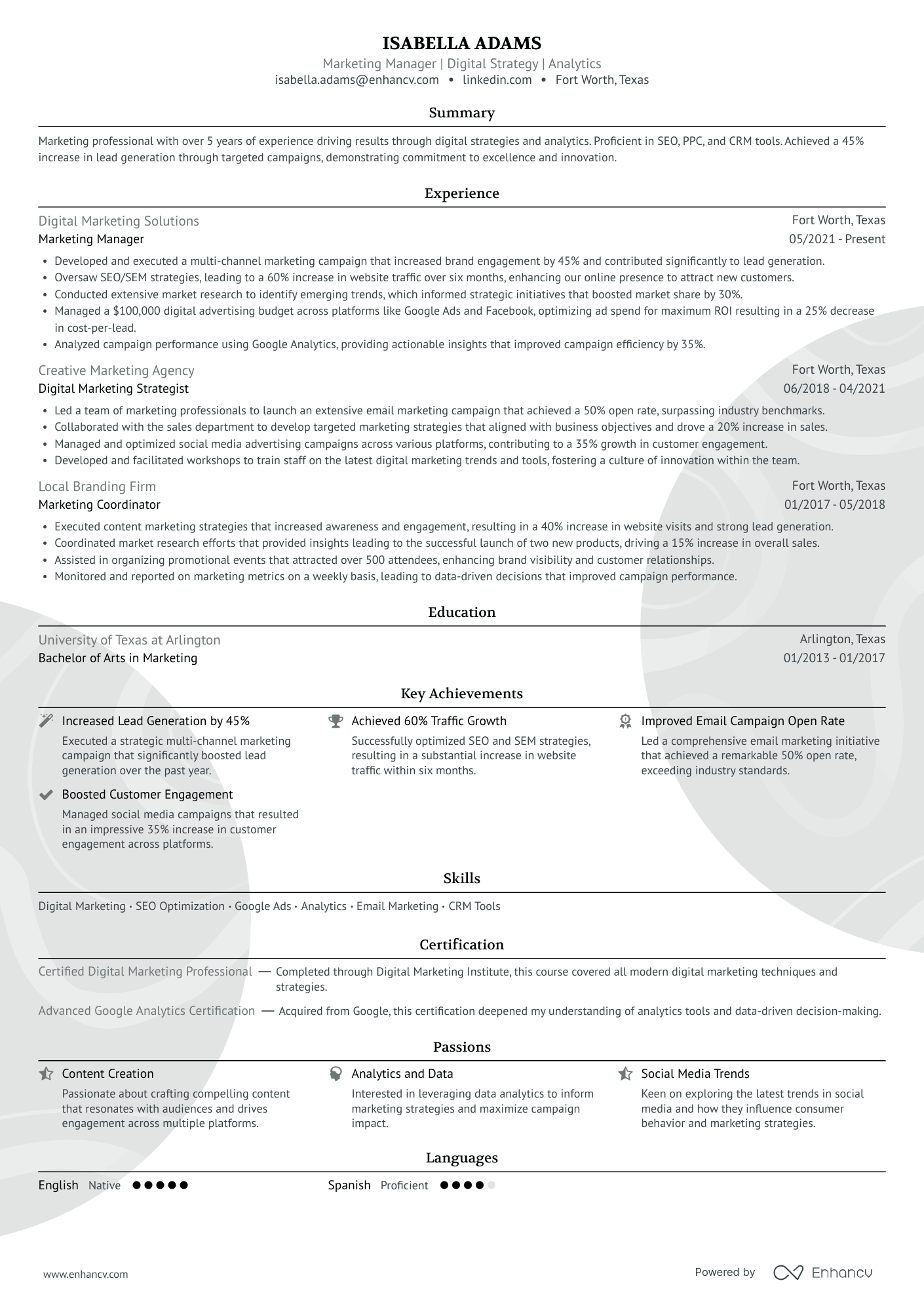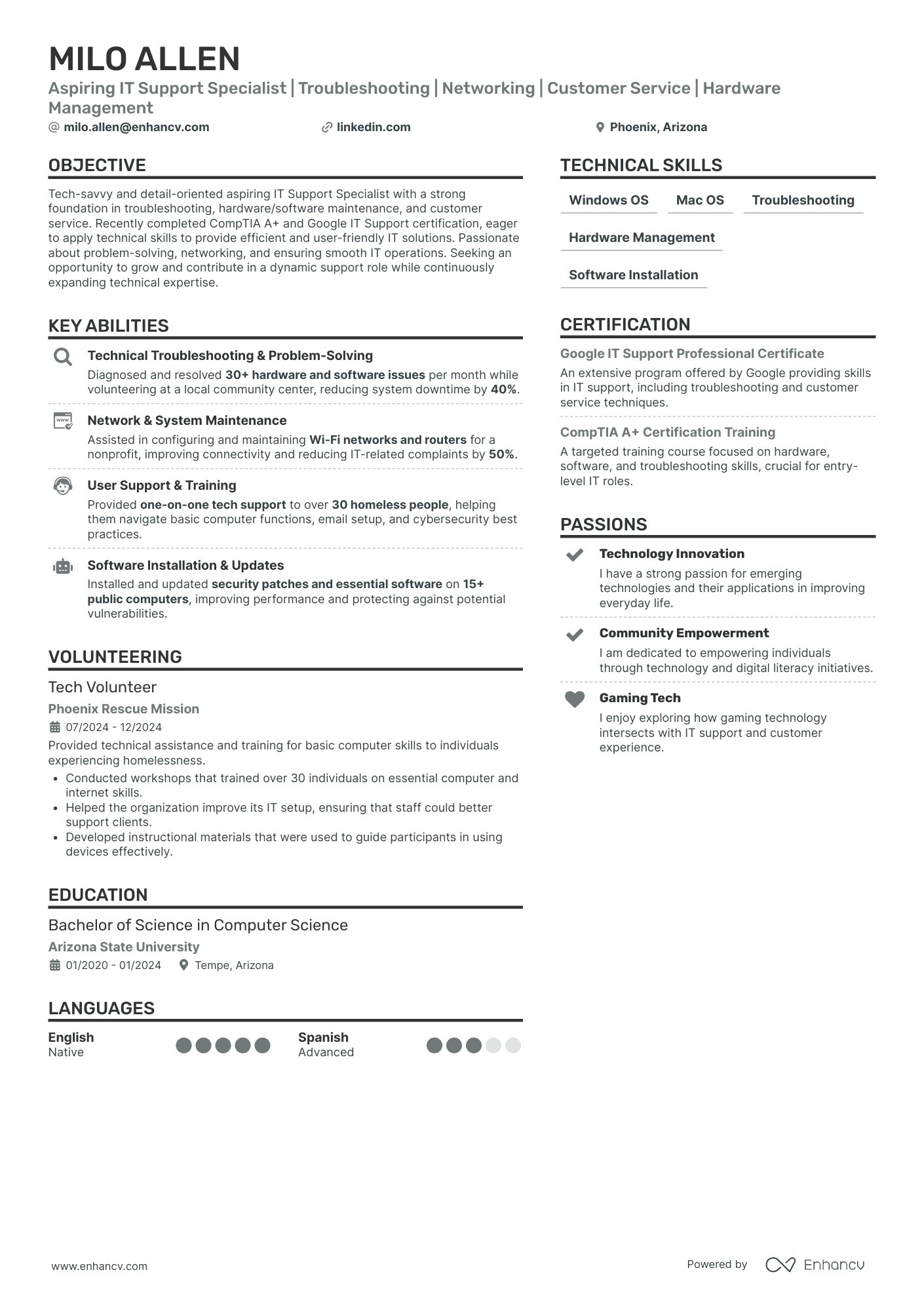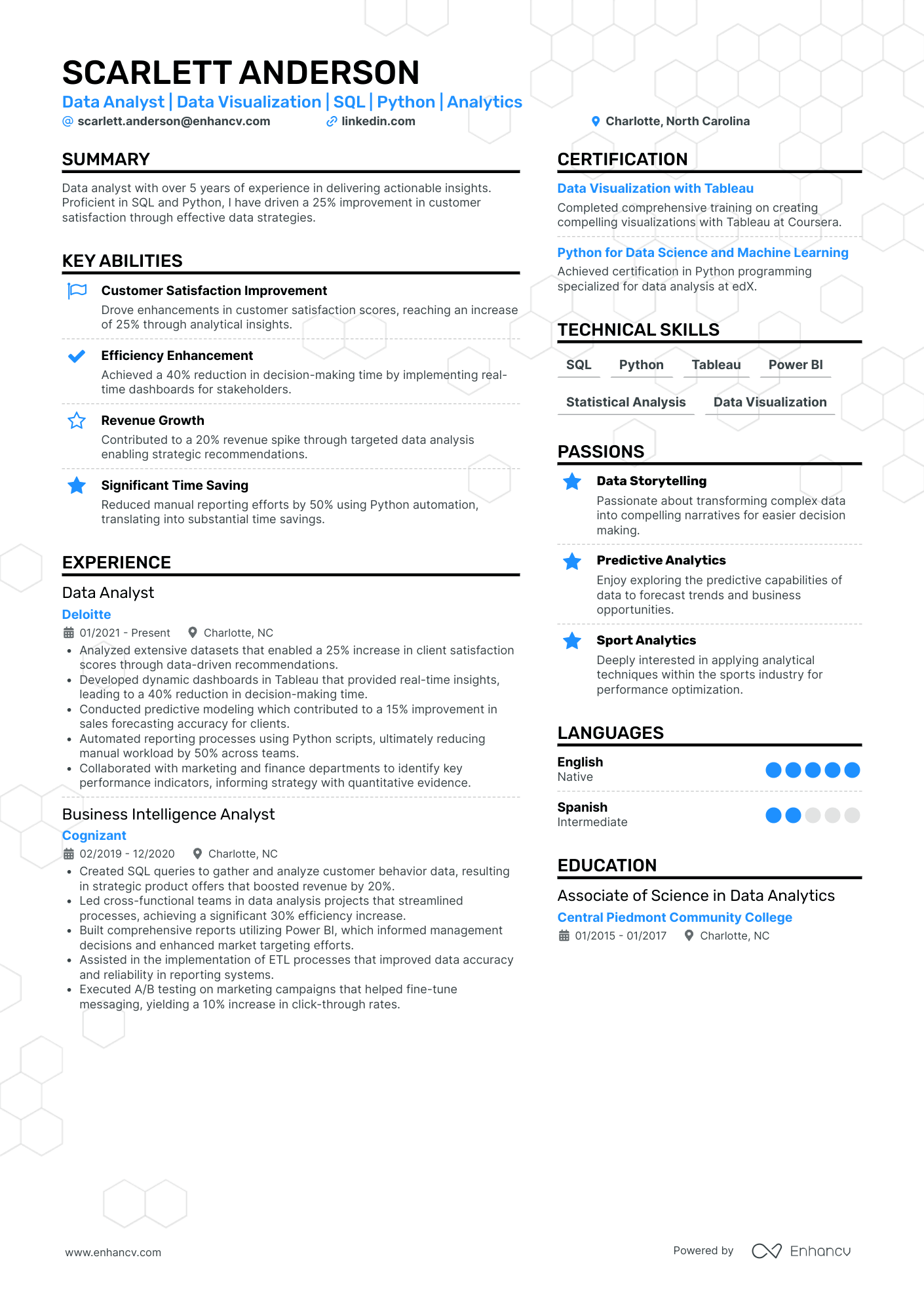A well-structured resume is a strategic document that presents your skills and experience in a compelling way. The structure of your resume plays a crucial role in how recruiters perceive you.
A clear, logical format allows hiring managers to quickly identify your strengths and determine if you're a good fit for the role. Meanwhile, a poorly organized resume can bury your application.
Whether you're a seasoned professional or just starting your career, mastering resume structure is the key to creating a document that opens doors to exciting opportunities.
In this guide, we’ll examine the essential elements of effective resume structure. We'll explore each in detail, discuss the best formatting options, and pinpoint the most common mistakes to avoid.
Key takeaways
- Modify the structure of your resume according to the role you target.
- Use reverse-chronological, functional, or hybrid resume format depending on career stage.
- Prioritize essential resume sections like Summary, Experience, Skills, and Education.
- Good formatting practices can help you create a visually appealing and well-structured document.
- Keep consistent formatting throughout your document to give it an orderly look.
Why resume structure matters
A well-structured resume is important for several reasons.
Here are a few examples:
- Positive first impression: Recruiters often spend mere seconds scanning each resume, so a clear and organized format is essential for capturing their attention.
- Professionalism and attention to detail: It shows that you've taken the time to craft a polished document, which reflects positively on your work ethic and communication abilities.
- Enhanced readability: It guides the reader's eye, making it easy to find key information like your skills, experience, and education.
- Pass ATS screening: Many companies use applicant tracking systems to filter resumes. A poorly formatted document can confuse the system, preventing your application from even reaching a human reviewer.
In other words, resume structure isn’t just about aesthetics—it's about maximizing your chances of being noticed and getting job interviews.
Resume structure and ATS
As you’re probably well aware, nowadays the majority of organizations use applicant tracking systems (ATS) to streamline their recruitment process. You might be wondering, how does resume structure relate to passing the initial ATS screenings?
Here’s what you should be aware of:
- Modern ATS is great at analyzing text-based documents.
- Clearly defined resume sections help to navigate the algorithms.
- Older software might be hindered by poor structure and formatting.
- Different systems will evaluate your resume with some variation.
The conclusion we can draw from these facts is that what matters most for passing ATS is relevant, accurate, and logically structured content. To further increase your chances of getting through, always tailor your resume using keywords from the job description.
PRO TIP
In case you already have a resume, you can use our AI-powered resume checker to start improving its structure and content right away.
Is your resume good enough?
Drop your resume here or choose a file. PDF & DOCX only. Max 2MB file size.
How to structure a resume
In this section, we’ll delve into the main components of a well-made resume and explore each in detail to understand how to present your qualifications in the best possible light.
Header and contact information
Your contact information should be the first thing on your resume—it’s what recruiters see first and how they’ll reach out to you. Make sure this section is clearly displayed at the top of your document.
What to include:
- Name: Use your legal name or the name you’re known by professionally.
- Phone contact: Provide a reliable phone number.
- Work-safe email address: Have a professional email address, ideally yourname@email.com, or a variation using your initials.
- LinkedIn URL: It allows recruiters to easily access your LinkedIn profile, which can provide more details about your experience and skills.
- Location: Add your city and state, but skip your full address. Consider if including your location is even relevant to the job you’re applying for.
Example:
PRO TIP
All the examples in this guide were made with Enhancv’s AI-powered resume builder. It’s the perfect tool to quickly build resumes tailored to any job description you want to target.
You benefit from:
- Dynamic resume structuring
- Creative templates and layouts
- AI content analysis and recommendations
- Reliable text formatting locked in by PDF file
Resume summary
Have the summary as the second section on your resume, right below the header. It serves as a brief introduction to your professional self and is your chance to grab the recruiter's attention right from the start.
A good summary is:
- Tailored to the job description
- Concise and easy to read (typically 3-4 sentences)
- Focused on your most relevant skills and achievements
Example:
Resume objective
If you’re an applicant without direct experience, use a resume objective instead of a summary. This brief statement of your professional goals is best for recent graduates, entry-level candidates, or career changers.
Example:
Work experience section
The work experience section is the core of your resume. Place it right after the summary to show your professional history and accomplishments. It's where you demonstrate the value you've brought in your previous roles.
Presenting your experience effectively is crucial for convincing recruiters that you're the right candidate for the job.
PRO TIP
Use reverse chronological order: organize your work experience starting with your most recent role and working backward. This format prioritizes your most recent and relevant experience.
How to structure each job entry
For each position you've held, include the following information in this order:
- Job title: Use the official job title of the roles you held.
- Company name: Include the full name of the organizations that employed you.
- Dates of employment: Specify the month and year you started and ended each role.
- Achievements: This is the most important part. Use bullet points to describe your most significant accomplishments. Focus on quantifiable results, using numbers and metrics, and start each entry with a strong action verb to make your descriptions more impactful.
Example experience entry:
- •Increased annual revenue by 45% by developing and implementing a new B2B sales strategy.
- •Expanded client base by 30% within two years by identifying and targeting high-value prospects.
- •Reduced sales cycle time by 25% through streamlined lead qualification and CRM automation.
- •Led a team of 12 sales representatives, boosting team productivity by 40% through coaching and performance tracking.
- •Negotiated high-value contracts, closing deals worth over $5M annually and surpassing sales targets by 20%.
Education section
The education section of your resume provides an overview of your academic qualifications. It's essential for presenting your educational background and any relevant degrees or coursework.
PRO TIP
List your educational credentials in reverse chronological order, starting with your most recent. The level of detail you include in this section will vary depending on your experience and the requirements of the jobs you're applying for.
For example, if you’re a recent graduate with a degree relevant to the role, then you can confidently expand your education section and list the most pertinent qualifications and skills you acquired during your studies.
Information to include:
- Degree name: List the full name of your degree (e.g., Bachelor of Science in Computer Science).
- Institution name: Add the school or university where you earned the degree.
- Graduation date: Include the month and year you graduated or expect to graduate.
- GPA: You can mention your GPA if it's high (typically above 3.5). If not, it's generally best to omit it.
- Honors/awards: List any relevant academic honors, awards, or scholarships you received.
- Relevant coursework: If you're a recent graduate with limited work experience, you can include a brief list of relevant coursework that aligns with your target roles.
Example:
- •Advanced Financial Modeling – Developed financial models for risk assessment and valuation.
- •Corporate Strategy – Analyzed case studies on Fortune 500 companies and their financial decisions.
- •Econometrics – Applied statistical methods to real-world economic data for predictive analysis.
- •Machine Learning for Business – Explored AI-driven decision-making in economic and financial models.
Skills section
The skills section of your resume is a vital component. It's a quick and easy way for recruiters to assess whether you possess the abilities necessary for the role. This section should focus on your most important hard skills.
PRO TIP
Hard skills refer to industry and role-specific competencies. While a dedicated Skills section works best for hard skills, remember to integrate them throughout other parts of your resume where you can show how you've applied them in real-world situations. This way you provide concrete examples of your expertise.
When listing tools and practical abilities, it's best to use a two-column design, which creates a good balance between your employment history and your skills. You can go one step further and organize your skills into categories to make them easy to read and understand.
Common hard skills categories include:
- Technical: Skills related to technology, software, programming languages, tools, and platforms.
- Industry-specific: Broad skills specific to your industry or profession such as content marketing, financial modeling, project management, etc.
Example:
To make your skills section more impactful, you can tie each ability to a specific accomplishment, as shown in the example above.
What about soft skills?
Soft skills are interpersonal abilities and other attributes related to how you interact with peers or customers.
Examples:
PRO TIP
While soft skills are important for every role, having a dedicated section for them on your resume isn’t preferable in most cases because they’re hard to quantify and fall flat when merely listed. It’s best to have them woven into the other sections of your document, giving examples of how you used them to accomplish impressive professional feats.
Choosing the right resume format
Another way to approach resume structure is through the three primary resume formats: chronological, functional, and combination (hybrid). They’re well-established and the vast majority of recruiters are familiar with them.
Choosing the right format depends on your career stage, work experience, industry standards, and the specific jobs you're targeting. Here we’ll take a look at each to understand their strengths.
Reverse-chronological format
The reverse-chronological resume is the most traditional and widely used format by individuals with a consistent work history. It emphasizes your professional experience, listing your jobs in reverse chronological order (most recent first).
- Pros: Easy to read, highlights career progression, and preferred by many recruiters.
- Cons: May not be the best choice for career changers or those with employment gaps.
- Good for: Candidates with linear career progression, traditional field workers, mid- to senior-level professionals.
Example:
Functional format
A functional or skill-based resume focuses on your abilities rather than your work history. It's a good option for recent graduates and those with little to no experience.
- Pros: Highlights your skills and uses transferable experience to convince recruiters you’re a good fit for a role.
- Cons: Can be viewed with skepticism by some hiring managers and it’s not suitable for all job types.
- Good for: Candidates with employment gaps, career changers, freelancers, stay-at-home parents, or those with diverse experiences.
Example:
Combination format
The combinationor hybrid resume uses elements of both the chronological and functional formats. It starts with an expanded skills section where you describe your key abilities in detail, followed by a chronological work history section.
This format allows you to demonstrate your skills while still providing a clear overview of your work experience. It can be a good option for career changers or roles where specific technical abilities are crucial.
- Pros: It’s flexible and adaptable. It can be seen as a unique and interesting approach to a role.
- Cons: It can be longer than other formats and requires careful planning and organization.
- Good for: IT specialists, project managers, product managers, marketers, and anyone changing industries.
Example:
Additional resume sections
We covered the essential resume sections. However, there are more ways to add value to your document to convince recruiters that you’re a prime candidate for a role.
Using additional sections strategically can set you apart from other applicants. Let’s take a look at the most common ones, what you should include in them, and where you should place them on your resume.
Certifications section
A list of certifications can be a valuable asset to your resume, especially if they’re relevant to your target jobs or industry. Your credentials represent your commitment to professional development and give you a competitive edge in the job market.
What to include:
- Certification name: State the full name of the certification.
- Certifying body: List the organization or institution that awarded the certification.
- Date of certification: Have the month and year the certification was issued, or, if it has a limited validity, list the expiration date.
- Certification number: If applicable, include a certification number or ID.
Placement tips:
- Relevance: Placement depends on the certifications’ relevance to your target jobs. If certifications are crucial for the roles you're seeking, place the section prominently after your skills or work experience section, but before the education section.
- Combination with education: If your certifications are closely related to your education, you can embed them within your academics under a relevant degree or program.
- Dedicated section: If you have several certifications or if they’re highly relevant to your career goals, create a separate "Certifications" section on your resume.
- Order: Within the certifications section, list your credentials in reverse-chronological order, starting with the most recent one.
- Prioritization: If you have many certificates, prioritize those most relevant to your target jobs.
Projects section
Aprojects section on your resume provides an opportunity to expand your professional frame with initiatives and accomplishments beyond your formal work experience. It's particularly useful for recent graduates, career changers, or individuals with limited work history.
What to include:
- Project name: Give your project a clear and concise name.
- Brief description: Write a brief description of the project, its purpose, and your role in it. Focus on the key objectives and outcomes.
- Technologies used (if applicable): List any relevant technologies, software, programming languages, or tools you used in the project.
- Key achievements/results: Mention your contribution and your achievements in the project.
Placement:
Put the projects section after your work experience (if applicable) or after your education section if you’re a recent graduate.
Awards and recognition
Not everybody can decorate their resume with an awards section. Having awards adds credibility to your profile and proves your excellence in your field. Including them can set you apart from other candidates, putting you in an exclusive category, and it shows an extraordinary dedication to your work.
What to include:
- Name: Clearly state the name of the award.
- Organization: Specify the organization or institution that granted the award.
- Date: Have the month and year you received the award.
- Description: If the award isn’t widely known, provide a brief description of its significance or criteria.
Placement:
Put the awards and recognition section after your work experience or education, depending on your preference and the relevance of the awards to the target role.
Volunteer experience section
Avolunteer experience section can be another useful addition that represents your commitment to your community, your values, and your willingness to contribute your skills to causes you care about. It also proves you’ve obtained skills and experience almost as credible as those gained through formal employment.
This section is particularly useful for recent graduates or career changers, or when applying for jobs that value community involvement or social responsibility.
What to include:
- Organization: State the name of the organization where you volunteered.
- Time period: Specify the duration.
- Description: Detail your role and accomplishments within the organization.
Placement:
Put the volunteer experience section after your work experience or education section, depending on your preference and the relevance of your volunteer work to the role.
Publications section
If you've authored any articles, books, research papers, or other written works relevant to the job you want to land, consider adding a publications section on your resume. It can be vital for roles in journalism, research, or academia.
What to include:
- Title: The full title of the article, book, or paper.
- Issuer: The name of the journal, magazine, or book publisher.
- Date: Have the month and year of publication.
- Authors: List the authors, including yourself, in the order they appear in the publication.
- Volume and issue: For journal articles, add the volume and issue number.
- DOI/Link: If applicable, insert the Digital Object Identifier (DOI) or a link to the publication.
Placement:
Put the publications section after your work experience or after your education section. It depends on your preference and the relevance of your publications to your career goals.
Languages section
In today's globalized world, language proficiency is a valuable asset that can open doors to certain opportunities. A languages section can be particularly beneficial if you're applying for jobs that require international collaboration or multilingual communication.
What to include:
- List the languages you speak.
- Detail the proficiency level of each (native, fluent, proficient, conversational, or basic).
- If you have any language certifications (e.g., TOEFL, IELTS), you can include them to add credibility to your claims.
Placement:
Put the languages section after your skills section, after your education section, or at the end of your resume, depending on your preference and their relevance to the role.
Career interests section
A personal interests section on a resume is optional and often debated. That’s why we recommend you modify it to a career interests section to align it with the role.
If you're an experienced professional with plenty of crucial details to include, an interests section might seem unnecessary. If you choose to include an interests section, it's crucial to do so strategically and thoughtfully.
What to include:
- Relevant interests: List and describe interests relevant to your target jobs or demonstrating valuable skills. For example, if you're applying for a marketing position, you might mention your passion for social media trends or content creation.
- Professional interests: Highlight interests that present your career aspirations or commitment to your field. For example, you might list any professional organizations you belong to or industry conferences you've attended.
Placement:
Put the interests section at the end of your resume. This way recruiters will be able to easily skip it in case they find it distracting.
How to use formatting to improve your resume’s structure
The content of your resume is important but its visual presentation and formatting also play a crucial role in how effective your document is.
A well-formatted resume is visually appealing and easier to read so take the time to implement the best practices outlined below.
- Headings and subheadings: Use clear and concise headings to delineate the different sections of your document. Make them visually distinct through bold font, a slightly larger font size, or a subtly different color. Consider adding lines to further organize information.
- Bullet points: Always use bullet points to break down your content into smaller bits. Keep them concise and focused, ideally limiting them to one line each. Also, use consistent bullet point styles throughout your resume.
- White space: White space refers to the empty space on your resume between sections, headings, and lines of text. You can increase the white space between sections to clearly separate them. Also, you can add extra space around headings and subheadings to make them easily noticeable.
- Fonts: Choose an easy-to-read font (e.g., Arial, Rubik, Calibri, Helvetica), generally between 10 and 12 points. Don’t use overly decorative or script fonts, which can be difficult to read, and keep a consistent font throughout your resume.
- Visual hierarchy: You can create a visual hierarchy by using a combination of no more than two font sizes and styles for headings, subheadings, and body text. This helps guide the reader's eye and makes it easier to scan your resume for key information. For example, use a larger font size for your name and section headings, and a smaller font size for bullet points and job descriptions.
- Alignment and margins: Use consistent alignment (left-aligned or justified) throughout your resume. Set appropriate margins (up to 1” on all sides) to make your resume well-balanced on the page.
Resume length
PRO TIP
In most cases, you should aim for a one-page resume. This is easily achievable even if you have a longer career history. However, according to our latest study, a more extensive resume will be appreciated in certain fields, such as research and academia. In these cases, it’s fine to have a two-page resume.
Common resume structure mistakes to avoid
Even with great resume content, poor structure can sabotage your efforts. This part of the article focuses specifically on structural mistakes that can hinder your resume's effectiveness.
Here’s what you should watch out for:
- Jumbled sections: A resume where sections aren’t clearly delineated makes it difficult for recruiters to quickly find the information they need.
- Overuse of graphics or templates: While a visually appealing resume is important, excessive graphics, unusual fonts, or overly creative templates can confuse recruiters and make your resume difficult to read.
- Inconsistent use of bullet points: Inconsistent use or a lack of bullet points makes your resume look cluttered.
- Lack of white space: A resume crammed with text and lacking white space is overwhelming.
- Putting irrelevant information first: Starting your resume with a less relevant or additional section weakens your application.
- Skills buried at the bottom: Don’t place your skills section at the bottom of your document. In all cases, display it prominently after your experience or side-by-side with it.
Frequently asked questions about resume structure
We covered the topic extensively but there are some common questions we should answer to spare you a lot of needless stress and confusion.
What is the best resume structure?
There’s no single best resume structure. How you present your content depends hugely on your circumstances. Essentially, your career stage and level of expertise point to your strengths which affects how you should structure your resume.
What is the best resume format?
All three main resume formats—reverse-chronological, functional, and hybrid—are useful, depending on the applicant's circumstances. You should choose the one that will present your professional qualifications in the best light possible.
What is the best order of resume sections?
Starting with your contact information and a summary/objective is the convention. But there are no strict rules to what follows next. This completely depends on the resume format you’re going for.
Conclusion
If you prioritize information, use appealing formatting, and follow our guide, you'll build a resume that's both well-structured and attractive to recruiters. This in itself is a testament to your strategic and logical thinking, which will be noticed by hiring managers.
Make one that's truly you.






